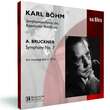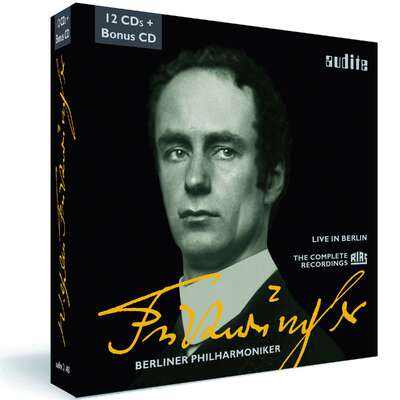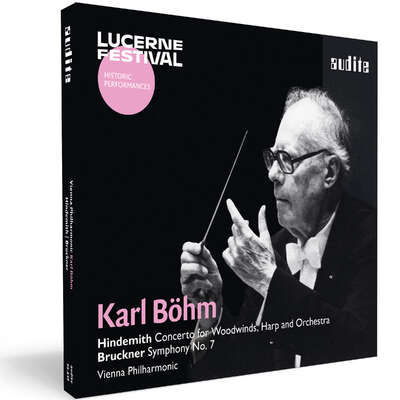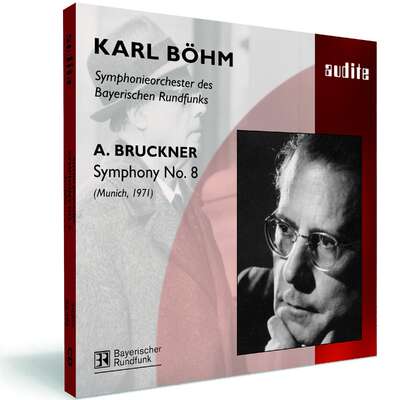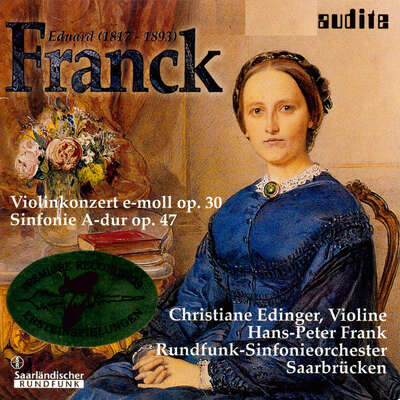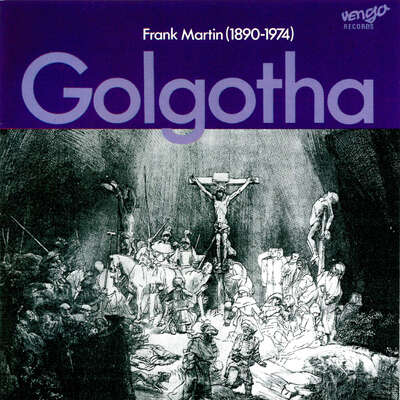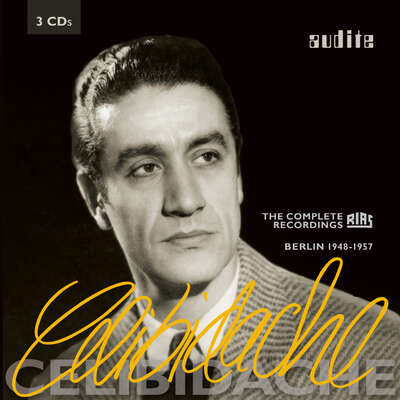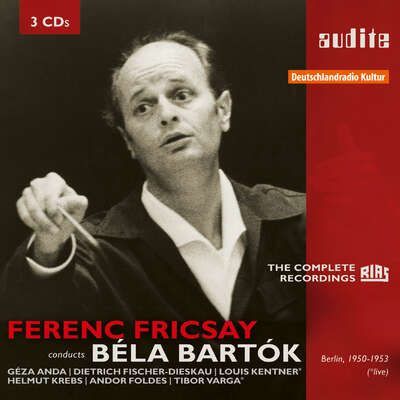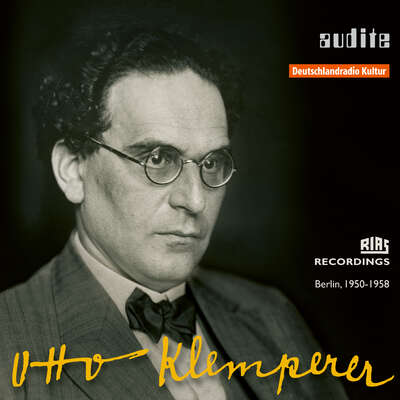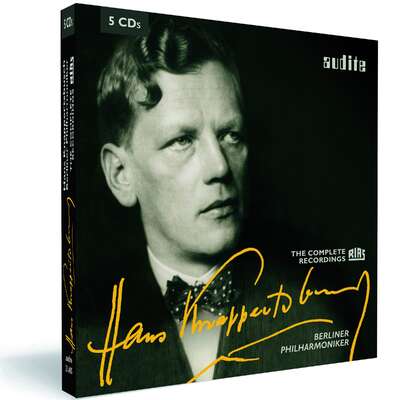
During his lifetime, Karl Böhm was a widely appreciated conductor of Bruckner with a thoroughly personal tone of his own to put up for discussion. The present recording of the Seventh Symphony with the Bavarian Radio Symphony Orchestra was made in 1977 and is therefore the latest made by...more
"Perhaps this is the kind of performance Böhm could only achieve onstage, and we are fortunate that it was recorded and now is made available to us in fine sound by Audite. A must for Bruckner lovers!" (ClassicsToday.com)
Details
| Anton Bruckner: Symphony No. 7 | |
| article number: | 95.494 |
|---|---|
| EAN barcode: | 4022143954947 |
| price group: | BCR |
| release date: | 22. August 2007 |
| total time: | 64 min. |
Bonus Material
Informationen
During his lifetime, Karl Böhm was a widely appreciated conductor of Bruckner with a thoroughly personal tone of his own to put up for discussion.
The present recording of the Seventh Symphony with the Bavarian Radio Symphony Orchestra was made in 1977 and is therefore the latest made by Böhm of this work. One can see especially clearly how Böhm performs Bruckner in the Seventh Symphony, the work which opens the trio of “Adagio Symphonies” but deviates from strictly symphonic writing in its lyrically wandering character. He avoids all semblance of enraptured, otherworldly monumentality with cantabile, long-breathed phrasing, loving attention to sonic and melodic detail and with a well thought-out dramaturgy of tempi. Böhm’s Bruckner shines in luminous colours and is infused with the warmth of an ever-present singing quality. This is no high-priest’s celebration of cool, distant symphonic architecture, but a down-to-earth, accessible Bruckner interpretation.
This CD is the third part of the historical Böhm series by audite.
Reviews
www.ionarts.org | 17.10.2012 | Charles T. Downey | October 17, 2012
They can’t all be winners. This week’s concerts from the NationalMehr lesen
www.classical.net | 25.06.2012 | José Luis Bermúdez | June 25, 2012
Although not terribly celebrated as a Bruckner conductor, Karl Böhm left aMehr lesen
Classic Collection | THURSDAY, DECEMBER 23, 2010 | Victor Carr | December 23, 2010
Böhm offers a beautiful conception of the work, wonderfully realized by the orchestra, with its famously gorgeous string sound and rich-toned brass. [...] Perhaps this is the kind of performance Böhm could only achieve on stage, and we are fortunate that it was recorded and now is made available to us in fine sound by Audite. A must for Bruckner lovers!Mehr lesen
Classical Weta 90,9 FM - Classical for Washington | December 2008 | Jens F. Laurson | December 11, 2008 Best Recordings of 2008
I don’t know which one of these recordings to nominate: never have IMehr lesen
levante | octobre 2008 | A. Gascó | October 1, 2008 La intimidad de Bruckner
Karl Böhm siempre tuvo una gran afinidad con la música de Bruckner. DeMehr lesen
Fanfare | Issue 32:1 (Sept/Oct 2008) | Jeffrey J. Lipscomb | September 1, 2008
Recorded in 1966, Solti’s studio Seventh from Vienna originally appeared on a pair of London LPs, where it was coupled with a Siegfried Idyll in theMehr lesen
Strictly in terms of execution, Böhm’s live Bruckner Seventh is a fine display of well-intoned strings, perky woodwinds, and generally solid brass-playing. So it’s with more than a little regret that I cannot recommend this one either. That’s simply because the Bavarians are up against two superior accounts from Böhm himself: his excellent 1976 studio version with the Vienna Philharmonic (65:48 on DG) and a slightly quicker and even more persuasive live 1976 Vienna concert reading (63:04 on Andante). While all three of those are similar in interpretive profile, Andante’s recording emerges as the most genial and spontaneous. Both Vienna Sevenths were recorded in the warm and spacious acoustics of Vienna’s Musikverein and sound more pleasing to the ear than Audite’s disappointingly colorless taping from the Herkulessaal in Munich.
Böhm’s Bruckner is most distinctive for its solid craftsmanship and first-class ensemble. In the studio Böhm often could sound too sober and unvaried (e.g., a drawback to his otherwise superbly played Fourth on Decca). But in his live Sevenths, the conductor is much more flexible in pace and phrasing. The only instance where this becomes a tad eccentric (in both live accounts) occurs in the first movement/second subject, where Böhm’s swift tempo suddenly slows right at the moment the big brass chorale is reached. Another minor criticism: the live Sevenths have a tiny hesitation just before the Adagio’s cymbal clash, which slightly diminishes the climax’s dramatic impact.
Both live readings feature some wonderfully stretched rubato in the brass passage leading to the Adagio’s livelier second subject. Böhm adroitly realizes this movement’s unusual bipartite tempo structure, where a slow first subject in 4/4 time is followed by a Moderato with three beats to the measure. Therefore, he correctly increases speed for the second subject, whereas some interpreters (e.g., the Solti reviewed above) just plod on as before. In the playing of this second subject, the Bavarian strings sound somewhat utilitarian in comparison to Vienna’s. The live Austrians play with an ineffable sweetness and lyricism that evokes Johann Strauss, Jr. (after all, Bruckner once remarked that he would rather hear a Strauss waltz than a Brahms symphony). The Scherzo in both live readings is bracingly alert and features an amiable Trio, but again the Viennese players sound much more Austrian. The tricky Finale has fine playing from both orchestras, but there is really nothing quite like the virtuosic solidarity of the Vienna brass.
The verdict: Böhm live in Vienna surely outclasses Böhm live in Munich. I went on to compare Andante’s release to five other stereo recordings from the Vienna Philharmonic and found Böhm to be more eloquent and idiomatic than the faceless Abbado (DG), the brusque Harnoncourt (Teldec), the aforementioned Solti, the strangely lackluster Giulini (DG), and the smooth but exceedingly detached Karajan (DG). Except for Harnoncourt, all of these conductors employ the disputed cymbal clash in the Adagio’s climax.
Of course, there are other interpretive approaches that certainly deserve a place in one’s “Seventh Heaven” collection. My choices here are all post 1956 and, with one exception, in stereo. A more dramatic first-movement coda than Böhm’s can be heard in the live 1992 Asahina/Osaka Philharmonic (63:01 on deleted Canyon; no cymbals) and in the 1967 Matačić/Czech Philharmonic (68:54 on Supraphon, with cymbals). Asahina’s rich, lower string-based sonorities are captured in terrific sound, and his agile, headlong gallop through the Scherzo is altogether thrilling. The Matačić is my favorite among the slower Sevenths (those lasting over 66 minutes). Its warmly lyrical phrasing benefits enormously from the Czechs’ distinctive instrumental timbres (see Paul Ingram’s favorable review in Fanfare 28:5). The 1964 Schuricht/Hague Philharmonic (60: 24 on deleted Scribendum; with cymbal clash) has moments of less-than-distinguished ensemble, but the reading is intensely passionate and its divided violins reveal many intriguing contrapuntal effects. Rosbaud’s 1957 Southwest German Radio studio account (63:09, without cymbals) is now on a Meisterwerke CD (misdated as 1959). The Austrian conductor (a native of Graz, as was Böhm) provides a veritable master class on how to use varied rates of string vibrato for expressive effect, and his brisk Finale is a marvel of pointed clarity. A special favorite of mine is the live 1960 radio broadcast (59:31, no cymbals), with Paul Hindemith leading the New York Philharmonic (Baton LP). The barely decent mono sound may suffer from hiss and a few sonic dropouts, but Hindemith’s profoundly insightful interpretation is riveting. Highly nuanced string phrasing, unusual tempo choices, and generous use of rubato create a most illuminating view of Bruckner from one of the last century’s greatest composers. The NYP needs to give us an official release in good sound (but see below).
Finally, here are a few purchasing suggestions. Böhm’s live Seventh on Andante is part of a four-disc Bruckner set (all Vienna Philharmonic) that includes Furtwängler’s 1954 Eighth and a Karajan Ninth from 1978 (see Robert McColley’s positive review of this set in Fanfare 27:1). The Furtwängler Eighth (excellent mono sound) is extraordinary. The stereo Karajan Ninth is committed but somewhat rough-edged. Andante’s set normally retails for about $56, but it recently was available via the Internet from Berkshire Record Outlet for $28 plus postage. The deleted Asahina and Schuricht items are hard to find and fetch high prices. Matačić’s is mid-priced ($12) and the Rosbaud is even cheaper (under $10); both can be bought at amazon.com. The Hindemith has appeared on a sub rosa CD from Disco Archivia (available from musicinthemail.com for $5 plus postage). I recently bought a copy and it seems to be a straight dub of the old Baton LP. Also included is a pair of Hindemith/New York bonuses: Cherubini’s Medea Overture (from the same concert as the Bruckner) and the overture to Weber’s Euryanthe (1963). Please be aware: what you get is a bare-bones CD-R in a plain plastic envelope (no notes). To my mind, each of those alternatives is a better value than Audite’s offering (retail price: roughly $18).
Scherzo | Febrero de 2008, Num. 227 | Enrique Pérez Adrián | February 1, 2008 Fricsay y Böhm (II)
Cuatro nuevos álbumes Audite (distribuidor: Diverdi) dedicados a Fricsay yMehr lesen
Pizzicato | 1/2008 | Rémy Franck | January 1, 2008 Böhms genialer Bruckner
Dies ist eine herausragende Deutung Anton Bruckners 7. Symphonie, denn Karl Böhm durchdringt das Werk mit einer ganz außergewöhnlichen geistigenMehr lesen
Diapason | janvier 2008 | Rémy Louis | January 1, 2008
-
-
Cette première parution officielle de gravures déjà éditées en CD de façon confidentielle élève toujours plus haut la statue brucknérienne deMehr lesen
Voisine dans l'esprit du légendaire disque avec Vienne (DG, 1976) et de son miroir en public (Andante), cette 7e est cependant tout autre, du fait de la personnalité sonore marquante de l'Orchestre de la Radio bavaroise. Elle communique une sensation irrésistible de plénitude et de lyrisme. L'élan intérieur, le galbe et la fluidité des phrasés, le génie de la transparence et celui de la continuité – dont tant de chefs aujourd'hui se dédouanent imprudemment –exposent la symphonie comme un tout perceptible comme tel dès les premières mesures. Portée par une tension subtilement nuancée, la narration est d'une tendresse douloureuse (le sublime passage précédant la coda de l'Allegro moderato, toute la fin de l'Adagio) : tout ici parle et nous parle, y compris le rythme « pesant » du Scherzo, que le Styrien Karl Böhm, amoureux de la nature, vit et respire aussi naturellement que le faisait le Souabe Eugen Jochum.
La même pertinence de la dramaturgie interne de l'œuvre, absolument tenue mais conflictualisée, quasi protestataire (et jamais extérieure ni sentimentale : l'Adagio) cauteleuse une 8e fulgurante, d'une concentration lapidaire, qui annonce celle, immortelle, donnée a Zurich en 1978 (Palexa. Diapason d'or de l'année). Elle dévoile la violence intérieure, la passion vertigineuse dont Böhm, si tranquille par ailleurs, était capable – pour le dire de façon métaphorique : là où tant de ses collègues invoquent Parsifal, le chef autrichien pense Tristan. Ce Bruckner vécu à hauteur d'homme, avec une simplicité et une évidence magistrales, demeure absolument juste, actuel, nécessaire. L'un des plus clairs qui soient (d'esprit, d'allure, d'architecture), il reste, et c'est a peine un paradoxe, l'un des plus mystérieux – ce mystère qui est aussi, pour partie, celui de Karl Böhm lui-même.
Le Monde de la Musique | Janvier 2008 | Patrick Szersnovicz | January 1, 2008
-
-
S'ouvrant sur un thème initial d'une indicible grandeur, la Septième Symphonie (1881 1883) de Bruckner possede une monumentalité plus directe queMehr lesen
Interprète d'élection de cette œuvre avec Jochum, Furtwängler, Van Beinum et Karajan, Karl Böhm en a laisse plusieurs enregistrements de premier ordre, dont un, célèbre, en 1976, avec les Wiener Philharmoniker (DG). Enregistré par la Radio bavaroise l’année suivante, le présent témoignage s'impose par une tension qui repose sur une assise exceptionnelle des basses. Si l'importance des voix intermédiaires met en avant quelques rugosités très allemandes, tout est puissamment intègre dans cette direction ou la musique est saisie dans sa globalité. Cette interprétation préfère a la mystique d'un Jochum déjà perdu dans l'extase de l'au delà une vision plus humaine et dramatique. Böhm s'appuie sur des tempos plutôt enlevés – excepte dans un « Adagio » à la pulsation profonde –, sur un phrase souple et expressif et sur une articulation et des contrastes parfaitement observés. Les amateurs de stricte objectivité ne trouveront pas leur compte dans cette vision engagée, impérieuse et abrupte, mais qui s'identifie en profondeur a la mélancolie lyrique de l'œuvre.
Diverdi Magazin | 164 / noviembre 2007 | Miguel Ángel González Barrio | November 1, 2007
El Bruckner luminoso de Karl Böhm
Inéditas grabaciones de Séptima y Octava por el maestro de Graz
El nombre de Karl Böhm no es asociado por lo general con la música de Anton Bruckner, como sí lo es universalmente con la de Mozart o Strauss. SinMehr lesen
El sello Audite, perseverante explorador de los archivos de la Radio de Baviera, ha exhumado sendos registros de Séptima (grabación en vivo del 5 de abril de 1977) y Octava (producción radiofónica en condiciones de estudio, nunca comercializada, de noviembre de 1971) con la Orquesta de la Radio, maravillosa formación que Rafael Kubelik heredó de Eugen Jochum y convirtió en una de las mejores de Europa. Ninguna es novedad, pero habían circulado poco, prácticamente sólo en Japón (la Octava vio una edición en el efímero sello italiano Originals), y el sonido de Audite no admite comparación. La (re)edición es oportuna, pues permite un nuevo acercamiento al Bruckner lúcido y honesto del maestro de Graz, y porque estas grabaciones son posiblemente las más satisfactorias de un copioso legado: nada menos que diez registros de la Séptima y seis de la Octava.
El Bruckner de Böhm impacta desde la primera audición por la riqueza de la paleta orquestal, la imponente belleza sonora (v.g. el arranque de la Séptima) y la celosa búsqueda de la transparencia. Böhm deja hablar a la música, que se explica a sí misma sin imposiciones externas. Huye de la opulencia sonora (los ff y fff nunca son opresivos), de la monumentalidad (por comparación con otros directores, las Codas, sabiamente construidas, pedagógicas, diáfanas, se antojan modestas; falsamente modestas), y prima el lirismo contenido, sin cargar jamás las tintas, pero sin distanciamiento (Haitink); el fraseo natural, el discurso fluido, sin resquicios, la cantabilidad, influencia de su experiencia como director de foso. No encontramos aquí exageradas pausas agógicas: los bloques se nos aparecen íntimamente ligados, sin que se resienta la coherencia estructural. Si acaso, los pasajes de especial significación son precedidos por un sutil ritardando (v.g. Coda del Allegro moderato de la Séptima, preparación del clímax del Adagio de la Octava). Hay detalles sorprendentes, chocantes incluso. En el Scherzo de la Séptima, Böhm gana impulso poco a poco hasta situarse a tempo. En este movimiento se deja sentir la vena austríaca: la batuta destaca los aspectos líricos y rústicos de origen campesino, sin perder de vista el humor de algunas células, como las encomendadas a los clarinetes; por el contrario, el Trío es más sosegado y sensual que de costumbre, constituyendo un interludio de onírica placidez. Especialmente memorables son los pasajes con diálogos entre las maderas (13:27 del Allegro moderato de la sinfonía en Mi mayor), prominentes por el balance favorecido por la batuta y espléndidamente captadas por los micrófonos de la radio bávara, y entre éstas y la cuerda (p.ej. 7:44 y ss. en el Adagio de la Octava). La respuesta orquestal es admirable. Señalemos un desliz aislado: en el movimiento inicial de la Séptima, los oboes se adelantan a los violines (8:03), lo que provoca un sonoro pisotón del director.
www.classicstodayfrance.com | Octobre 2007 | Christophe Huss | October 26, 2007
On ne va pas faire durer le suspense: cet enregistrement est à laMehr lesen
www.ClassicsToday.com | October 2007 | Victor Carr | October 1, 2007
Seven months prior to this April, 1977 live performance Karl Böhm recordedMehr lesen
klassik.com | September 2007 | Aron Sayed | September 23, 2007 | source: http://magazin.k... Monumentales Schweben
Den österreichischen Dirigenten Karl Böhm (1894-1981) kennt man eher alsMehr lesen
